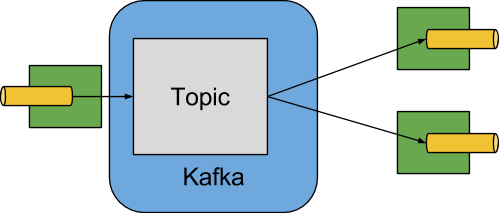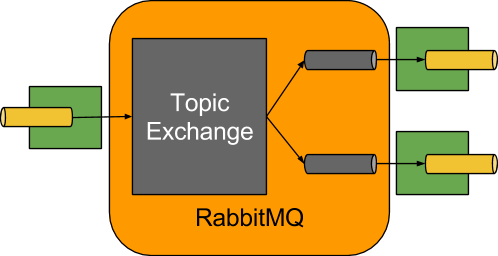This section describes Spring Cloud Stream’s programming model. Spring Cloud Stream provides a number of predefined annotations for declaring bound input and output channels as well as how to listen to channels.
You can turn a Spring application into a Spring Cloud Stream application by applying the @EnableBinding annotation to one of the application’s configuration classes.
The @EnableBinding annotation itself is meta-annotated with @Configuration and triggers the configuration of Spring Cloud Stream infrastructure:
... @Import(...) @Configuration @EnableIntegration public @interface EnableBinding { ... Class<?>[] value() default {}; }
The @EnableBinding annotation can take as parameters one or more interface classes that contain methods which represent bindable components (typically message channels).
![[Note]](images/note.png) | Note |
|---|---|
In Spring Cloud Stream 1.0, the only supported bindable components are the Spring Messaging |
A Spring Cloud Stream application can have an arbitrary number of input and output channels defined in an interface as @Input and @Output methods:
public interface Barista { @Input SubscribableChannel orders(); @Output MessageChannel hotDrinks(); @Output MessageChannel coldDrinks(); }
Using this interface as a parameter to @EnableBinding will trigger the creation of three bound channels named orders, hotDrinks, and coldDrinks, respectively.
@EnableBinding(Barista.class) public class CafeConfiguration { ... }
Using the @Input and @Output annotations, you can specify a customized channel name for the channel, as shown in the following example:
public interface Barista { ... @Input("inboundOrders") SubscribableChannel orders(); }
In this example, the created bound channel will be named inboundOrders.
For easy addressing of the most common use cases, which involve either an input channel, an output channel, or both, Spring Cloud Stream provides three predefined interfaces out of the box.
Source can be used for an application which has a single outbound channel.
public interface Source { String OUTPUT = "output"; @Output(Source.OUTPUT) MessageChannel output(); }
Sink can be used for an application which has a single inbound channel.
public interface Sink { String INPUT = "input"; @Input(Sink.INPUT) SubscribableChannel input(); }
Processor can be used for an application which has both an inbound channel and an outbound channel.
public interface Processor extends Source, Sink { }
Spring Cloud Stream provides no special handling for any of these interfaces; they are only provided out of the box.
For each bound interface, Spring Cloud Stream will generate a bean that implements the interface.
Invoking a @Input-annotated or @Output-annotated method of one of these beans will return the relevant bound channel.
The bean in the following example sends a message on the output channel when its hello method is invoked.
It invokes output() on the injected Source bean to retrieve the target channel.
@Component public class SendingBean { private Source source; @Autowired public SendingBean(Source source) { this.source = source; } public void sayHello(String name) { source.output().send(MessageBuilder.withPayload(body).build()); } }
Bound channels can be also injected directly:
@Component public class SendingBean { private MessageChannel output; @Autowired public SendingBean(MessageChannel output) { this.output = output; } public void sayHello(String name) { output.send(MessageBuilder.withPayload(body).build()); } }
If the name of the channel is customized on the declaring annotation, that name should be used instead of the method name. Given the following declaration:
public interface CustomSource { ... @Output("customOutput") MessageChannel output(); }
The channel will be injected as shown in the following example:
@Component public class SendingBean { @Autowired private MessageChannel output; @Autowired @Qualifier("customOutput") public SendingBean(MessageChannel output) { this.output = output; } public void sayHello(String name) { customOutput.send(MessageBuilder.withPayload(body).build()); } }
You can write a Spring Cloud Stream application using either Spring Integration annotations or Spring Cloud Stream’s @StreamListener annotation.
The @StreamListener annotation is modeled after other Spring Messaging annotations (such as @MessageMapping, @JmsListener, @RabbitListener, etc.) but adds content type management and type coercion features.
Because Spring Cloud Stream is based on Spring Integration, Stream completely inherits Integration’s foundation and infrastructure as well as the component itself.
For example, you can attach the output channel of a Source to a MessageSource:
@EnableBinding(Source.class) public class TimerSource { @Value("${format}") private String format; @Bean @InboundChannelAdapter(value = Source.OUTPUT, poller = @Poller(fixedDelay = "${fixedDelay}", maxMessagesPerPoll = "1")) public MessageSource<String> timerMessageSource() { return () -> new GenericMessage<>(new SimpleDateFormat(format).format(new Date())); } }
Or you can use a processor’s channels in a transformer:
@EnableBinding(Processor.class) public class TransformProcessor { @Transformer(inputChannel = Processor.INPUT, outputChannel = Processor.OUTPUT) public Object transform(String message) { return message.toUpper(); } }
Complementary to its Spring Integration support, Spring Cloud Stream provides its own @StreamListener annotation, modeled after other Spring Messaging annotations (e.g. @MessageMapping, @JmsListener, @RabbitListener, etc.).
The @StreamListener annotation provides a simpler model for handling inbound messages, especially when dealing with use cases that involve content type management and type coercion.
Spring Cloud Stream provides an extensible MessageConverter mechanism for handling data conversion by bound channels and for, in this case, dispatching to methods annotated with @StreamListener.
The following is an example of an application which processes external Vote events:
@EnableBinding(Sink.class) public class VoteHandler { @Autowired VotingService votingService; @StreamListener(Sink.INPUT) public void handle(Vote vote) { votingService.record(vote); } }
The distinction between @StreamListener and a Spring Integration @ServiceActivator is seen when considering an inbound Message that has a String payload and a contentType header of application/json.
In the case of @StreamListener, the MessageConverter mechanism will use the contentType header to parse the String payload into a Vote object.
As with other Spring Messaging methods, method arguments can be annotated with @Payload, @Headers and @Header.
![[Note]](images/note.png) | Note |
|---|---|
For methods which return data, you must use the @EnableBinding(Processor.class) public class TransformProcessor { @Autowired VotingService votingService; @StreamListener(Processor.INPUT) @SendTo(Processor.OUTPUT) public VoteResult handle(Vote vote) { return votingService.record(vote); } } |
![[Note]](images/note.png) | Note |
|---|---|
In the case of RabbitMQ, content type headers can be set by external applications. Spring Cloud Stream supports them as part of an extended internal protocol used for any type of transport (including transports, such as Kafka, that do not normally support headers). |
Spring Cloud Stream provides a Binder abstraction for use in connecting to physical destinations. This section provides information about the main concepts behind the Binder SPI, its main components, and implementation-specific details.
A producer is any component that sends messages to a channel.
The channel can be bound to an external message broker via a Binder implementation for that broker.
When invoking the bindProducer() method, the first parameter is the name of the destination within the broker, the second parameter is the local channel instance to which the producer will send messages, and the third parameter contains properties (such as a partition key expression) to be used within the adapter that is created for that channel.
A consumer is any component that receives messages from a channel.
As with a producer, the consumer’s channel can be bound to an external message broker.
When invoking the bindConsumer() method, the first parameter is the destination name, and a second parameter provides the name of a logical group of consumers.
Each group that is represented by consumer bindings for a given destination receives a copy of each message that a producer sends to that destination (i.e., publish-subscribe semantics).
If there are multiple consumer instances bound using the same group name, then messages will be load-balanced across those consumer instances so that each message sent by a producer is consumed by only a single consumer instance within each group (i.e., queueing semantics).
The Kafka Binder implementation maps the destination to a Kafka topic. The consumer group maps directly to the same Kafka concept. Spring Cloud Stream does not use the high-level consumer, but implements a similar concept for the simple consumer.
The RabbitMQ Binder implementation maps the destination to a TopicExchange.
For each consumer group, a Queue will be bound to that TopicExchange.
Each consumer instance that binds will trigger creation of a corresponding RabbitMQ Consumer instance for its group’s Queue.


